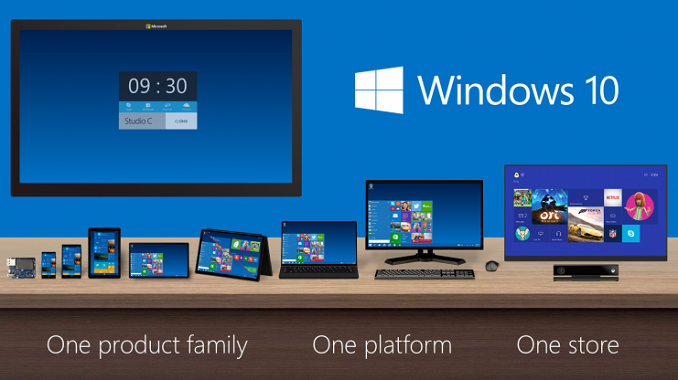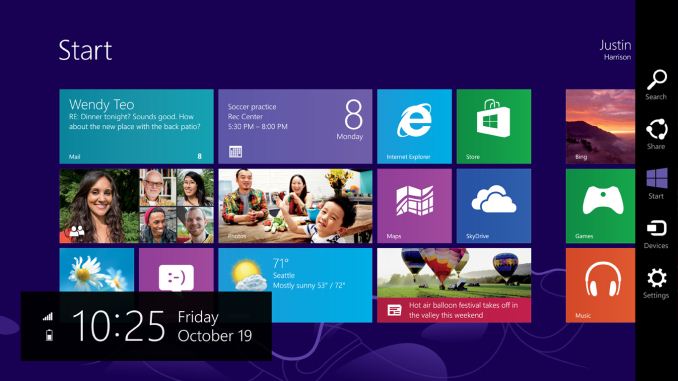Windows 10 Technical Preview First Impressions: The Return Of The Desktop
by Brett Howse on November 13, 2014 8:00 AM EST- Posted in
- Software
- Microsoft
- Windows 10

I’ve said this before, and I will reiterate it now. Windows 8, in general, is not perceived in a positive light. Not necessarily because of the lack of features, or even due to the touch first interface, but because from the start people did not buy into the paradigm. We can argue over why that was, and the specifics are likely different for every individual. But a big part of that was that Windows, which has had a familiar interface since Windows 95, had changed dramatically in look, feel, and general use. The traditional mouse and keyboard PC and notebook is a big part of the Windows user base, and especially at the beginning, Windows 8 did not cater to that crowd. While there were certainly improvements to the desktop, it was not enough to overcome the negative feelings of many users in regards to being productive on their PC. I say this as a fan of Windows 8.1, and I say this despite the positive review from this site. Windows 8 was an OS that worked, but had a steep learning curve that many people did not want to bother learning.
One of the biggest issues facing Windows 8 was just how much people liked Windows 7. Windows 7 was seen as the savior to Vista, and fixed many of its issues. But a lot of the initial problems with Vista were due to a major change in the driver model as well as the security model, which caused a lot of compatibility issues with older programs which expected administrator rights, as well as many hardware devices needed driver updates. With Windows 7, all of those changes were in the rear view mirror, allowing 7 to be a tweak of the overall UI and functionality rather than a rebuild of the OS from the ground up. With Windows 8, the move to touch first caused another dramatic upheaval. This time, rather than incompatible programs and hardware, we got a new Start Screen, a new runtime in WinRT, and a new app model with the Windows Store. For reasons that will never be made clear, the familiar start button was even removed, with the designers relying on hidden functions such as the hot corners to navigate around the OS with a mouse and keyboard. Luckily this change was reversed for Windows 8.1, with the start button returning, even if it still opened the Start Screen. With the Windows 8.1 Update, the system was made much more usable for a mouse and keyboard with the return of the menu bar to close apps, rather than dragging them down off the screen, and several other changes as well which brought the balance back somewhat to cover both touch interfaces as well as the mouse and keyboard.
 Windows 8 at launch in October 2012
Windows 8 at launch in October 2012
With Windows 8, Microsoft tried out an operating system which would work with a single interface across a breadth of hardware, from small form factor tablets, up to 30” monitor desktops. While they certainly succeeded in creating an interface that worked across all of those platforms, it was not ideally suited to any of them. With the tablet mode, the new Start Screen worked very well, and the charms menu and app switcher were fairly easy to use. But many of the settings and programs would be on the desktop, where touch only worked sparingly. Some desktop applications, such as Office, were created with a touch mode to increase the size of the onscreen elements, but overall the experience was subpar. Similarly, on the desktop, the touch interfaces were not ideal, and the hot corners certainly had issues especially on multi-monitor systems.
Windows 10 Technical Preview at launch
But now we come to Windows 10. Windows 10 is ditching the “One Interface to Rule them All” mentality, and moving to a more user friendly model of a single store across all platforms, and multiple interfaces to the same OS depending on the current usage model. We have not seen all of this in practice as of yet in the Technical Preview, but Microsoft has demonstrated their solution to this change in input mode with a feature they are calling Continuum.
The goal is that those that are on a keyboard and mouse based system will have the traditional start menu and desktop, with apps in windows, but if you are on a touch based device, or if you go on a 2-in-1 from keyboard to touch, the system will switch to the Windows 8 style start screen with full screen apps.
One of the keys to having this experience is an app model that allows a developer to target this different user interface paradigms. Microsoft’s solution to this is Universal Apps.











198 Comments
View All Comments
Spawne32 - Thursday, November 13, 2014 - link
If you think Windows 10 will be free, you are wrong, they have already announced that Windows 10 will NOT be free, they will offer discounted upgrade paths for windows 7 and windows 8/8.1 users, but never in the history of Microsoft has windows ever been offered as a "free upgrade".jt122333221 - Thursday, November 13, 2014 - link
While this is more a "sp1" upgrade, Windows 8.1 was free and changed the name of the OS version (instead of appending SP1 or SP2 to the name). I would consider that as a new version for free.Spawne32 - Thursday, November 13, 2014 - link
Windows 8.1 wasn't a new version, it was a patch to solve the doomed sales of Windows 8 itself because of how unusable it was.Gigaplex - Friday, November 14, 2014 - link
It didn't install cleanly as a patch, it was built as a new version.snajk138 - Sunday, November 16, 2014 - link
And how is that different from Windows 10?anthill - Thursday, November 13, 2014 - link
DirectX 12 support will push me to upgrade if 7 doesn't support it.zepi - Friday, November 14, 2014 - link
January 14, 2020That is the day when Windows 7 runs out of extended support and that is the date you should seriously consider upgrading even if you don't like the options available...
rangerdavid - Friday, November 14, 2014 - link
Exactly. Brilliant.designgears - Saturday, November 15, 2014 - link
The speed of windows 8 and 8.1 alone is worth the $100.Lerianis - Sunday, November 30, 2014 - link
Or they are going to have to give a free upgrade to Windows 10 for people to justify it. Seriously, I never understood the "You have to keep paying to upgrade Windows!" nonsense. Just allow us to buy the operating system ONCE and our key, OEM or Retail, works for ALL future versions of Windows.Microsoft does not make most of their money on upgrades.... they make it on original sales of machines.